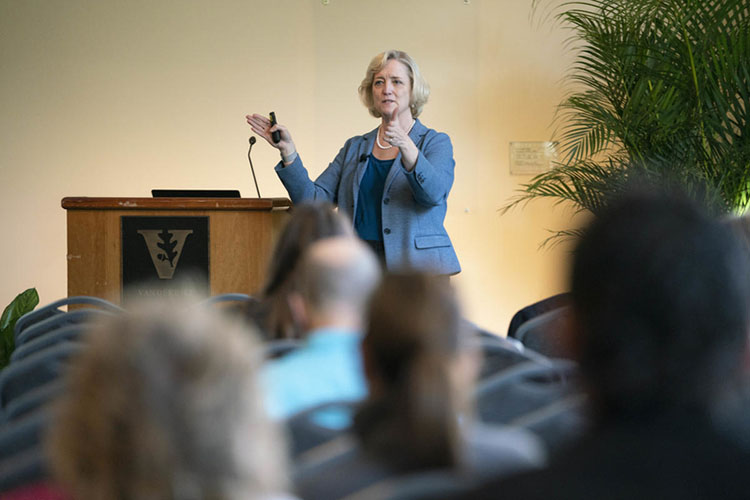
A recent town hall meeting gave Vanderbilt community members an update on progress being made on several of the university’s capital projects, as well as provided next steps in the planning processes surrounding academic buildings and spaces.
Interim Chancellor and Provost Susan R. Wente and Vice Chancellor for Administration Eric Kopstain hosted the Nov. 12 event in the Student Life Center Board of Trust Room. Those in attendance were guided neighborhood by neighborhood through some of the major building and infrastructure projects and campus planning efforts that are physically transforming the university.
“We wanted to host this town hall as an update not just on one set of plans, but on all of the work and planning that’s been going on over the last four to five years,” Wente said. “The framing we use for these efforts is our Academic Strategic Plan, which in turn drives our FutureVU campus planning process. We want our facilities and how our campus is built to support these strategies in terms of what we’re doing in research and education, teaching and learning.”
The FutureVU framework is driven by a set of guiding principles first articulated by the faculty, students and staff who participated in the initial land use planning process. Those principles include considering Vanderbilt as a community of neighborhoods that feature a distinctive, park-like setting, making the campus more walkable and sustainable, and placing high value on accessibility and inclusiveness when designing buildings and spaces.

Vanderbilt takes a data-driven approach in its capital planning and carefully sequences projects with respect to the academic-year calendar, Kopstain explained. The university relies on the expertise of its Facilities teams as well as external design and engineering firms, but also is deeply invested in the feedback of faculty, staff and students.
“We solicit the input of academic leaders, faculty, staff, students and community members about program needs and how we should use space,” Kopstain said. “Our plans are always improved and made stronger through feedback from across our community. We’re committed to having processes that are inclusive and take the time to seek and incorporate input.”
Wente and Kopstain recently appointed a new advisory committee comprised of faculty, staff and students from across the university to provide feedback on current FutureVU plans, concepts and options. The group will meet over the course of the spring 2020 semester.
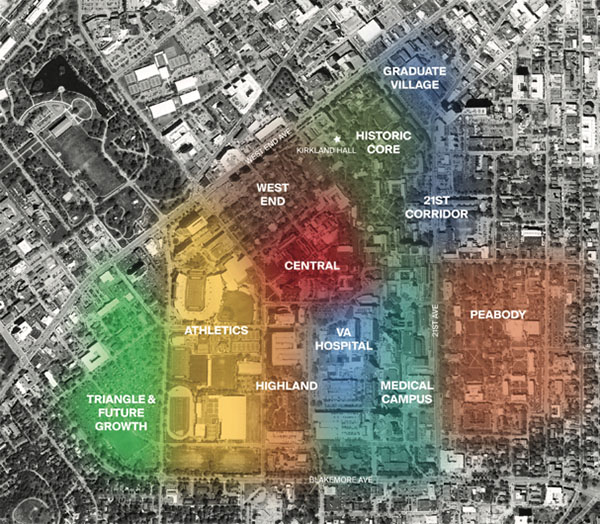
Wente and Kopstain discussed in detail the projects and planning efforts currently taking place in several of the university’s neighborhoods. Connectivity between these neighborhoods is key to the university’s planning efforts, the administrators said.
Peabody College
Phase 1 of a multi-building master plan to restore and enhance the Peabody College campus will renovate 60,000 square feet of existing space and add 10,000 square feet in new construction.
“These are wonderful buildings on the Peabody campus. In architectural terms, you sometimes say they have ‘great bones,’” Kopstain said. “We’re never going to take these buildings down, but they are in need of significant upgrades.”
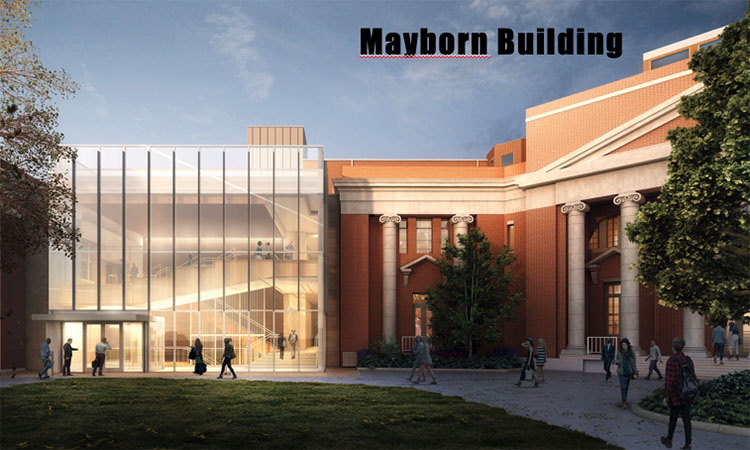
A revitalized Mayborn Building, initially opened in 1914 and intended as the home of Vanderbilt’s popular Human and Organizational Development program, will feature three active-learning classrooms and two configurable classrooms, a simulation lab for demonstration teaching and one-on-one counseling, an auditorium that seats 120, and “The Gallery,” an event space with capacity for 100 designed to facilitate opportunities for students to interact with representatives from local nonprofit organizations as well as community leaders.
A new connector building being constructed between the existing Mayborn and Home Economics buildings will feature three active-learning classrooms and two configurable classrooms, a new café, and an elevator providing multi-floor access to both Mayborn and Home Ec.
“Instead of going into the existing buildings individually and trying to find a way to meet the accessibility challenge, the connector building is a true architectural breakthrough in terms of constructing a beautiful, light-filled connector between the two that creates accessibility to both historic buildings on all levels,” Wente said. A number of sidewalks and pathways on the Peabody campus are also being made accessible.
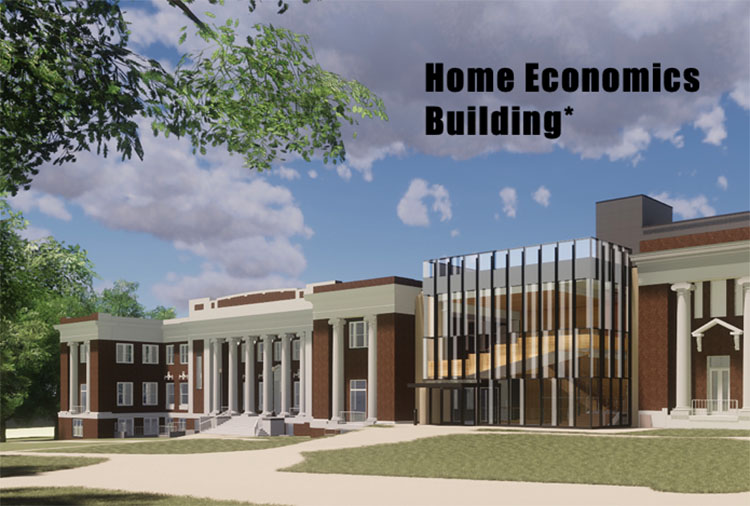
Renovations to the Home Economics Building, which also opened in 1914, are designed to strengthen Peabody College’s pedagogy and practice. Among the renovations are new science labs for K-12 programs and to teach instruction techniques, a makerspace for student use and to facilitate faculty design of learning experiences, eight configurable classrooms and three science classrooms, five research or project workrooms, and five project meeting rooms.
In addition, a more than $25 million project is underway on the Peabody campus to upgrade the original underground steam distribution system with more efficient and sustainable hot and chilled water lines, as well as to upgrade the information technology infrastructure.
“This was an important moment in that we realized the solution we’re putting in place does not have the lowest initial sticker price, but the investment will pay off quickly, as the new infrastructure is significantly more efficient and environmentally friendly and will serve not only the buildings we’re currently renovating, but future renovation projects and all of Peabody,” Kopstain said.
The target completion date for phase 1 of the Peabody master plan is May 2020. A phase 2 is under consideration, with proposals that include renovations to Payne Hall and the Peabody Library.
21st Avenue Corridor
The 21st Avenue Corridor is home to two major academic building projects completed in 2019. The School of Nursing finished a $23.6 million building expansion in January featuring a state-of-the-art simulation lab, technologically advanced classrooms and student services offices. The Divinity School completed an $11.5 million renovation project in August that added more than 13,600 square feet of space including five new classrooms with smart technology, expanded and updated conference rooms, renovated office space, a multi-faith chapel and a terrace.
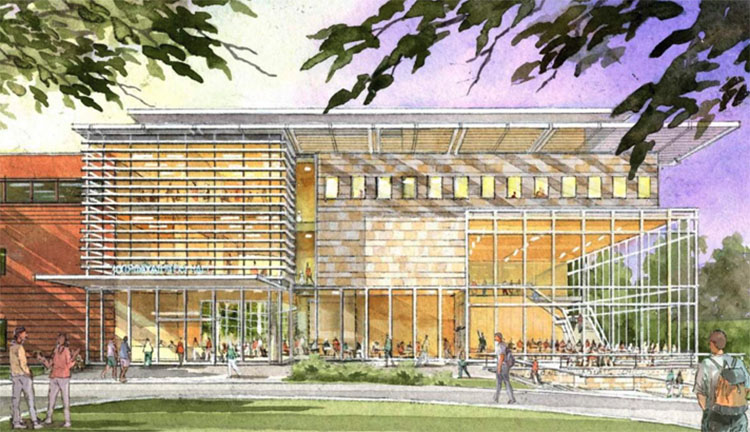
The Owen Graduate School of Management, built in 1981, is planning a renovation and addition project that would modernize its classrooms and bolster its connections to the surrounding community. The design concept under consideration features a more welcoming building entrance facing 21st Avenue South; large, flexible multi-use spaces; additional and upgraded classrooms; additional faculty offices; and refreshed and reorganized student services space—all aimed at strengthening the Owen School’s world-class educational experience on a personal scale. This design work continues, with a targeted construction start date of spring 2021.
“The vision for this addition and renovation is transformational not only in how it changes the inside of the building, but also in how it changes the outside, making it more welcoming and offering the community a view in,” Wente said. “The Owen School project is the next major project that, together with the Divinity and Nursing renovations, is transforming a significant portion of the 21st Avenue corridor.”
Plans for the property at 1101 19th Avenue, the former Disciples of Christ Historical Society Library Archives, include a new Digital Commons and Faculty Commons. “We purchased this building in 2015 and immediately began brainstorming what potential academic or other types of activities it could host in support of our mission,” Wente said. “From faculty input gathered across campus, this is now envisioned as a shared home for multiple new initiatives.”
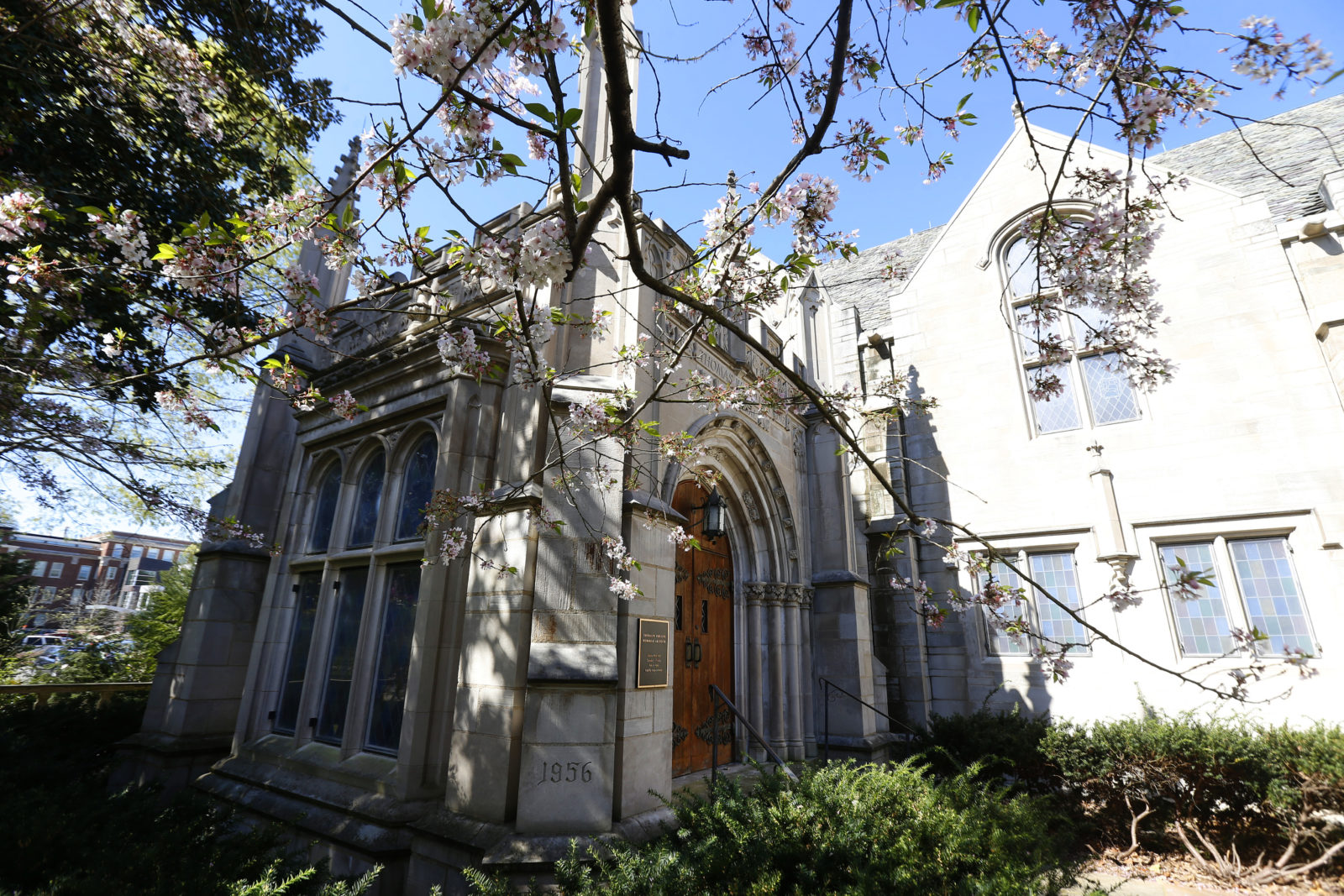
The Digital Commons will house the Center for Digital Humanities’ media lab, a video studio, a digitization lab and additional digital resource and project support space. The Faculty Commons will feature space to facilitate faculty development and host social events, a lounge and multipurpose rooms, and serve as the administrative home for the Faculty Senate. Demolition to the inside of the Tudor Gothic-style building, constructed in 1956, is currently underway, with renovations slated to begin this January and a target open date of fall 2020.
Graduate and Professional Student Village
The first phase of Vanderbilt’s new Graduate and Professional Student Village will be constructed at the corner of 20th Avenue and Broadway. The initial 600-bed development will provide a much-needed housing option near campus at below-market rates for Vanderbilt’s graduate and professional student population. The development is designed to enhance Vanderbilt’s ability to recruit the best and brightest graduate and professional students to the university and a rapidly growing Nashville—and to build community and interdisciplinary connections among them once they’re here.
“Unlike many of our peer institutions, we have zero dedicated graduate and professional student housing to date,” Kopstain said. “The fact that we don’t have this could become a strategic disadvantage, and this is all happening at a time when Nashville is rapidly developing and rapidly gentrifying.
“Our students work really hard, they work around the clock, and they’d like to be right nearby. We’d like to have them right nearby,” he said.
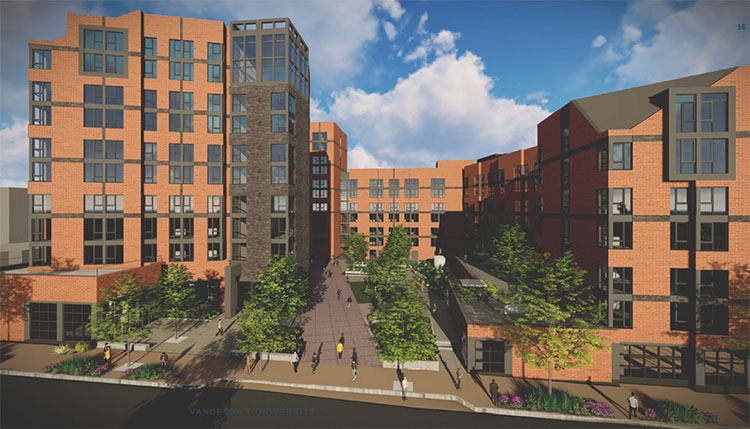
The Graduate and Professional Student Village—which will feature a public courtyard, interactive study space, retail businesses including a grocery store, and other amenities—is being developed through a public-private partnership with the international firm Lendlease.
“Given the unique needs of graduate students and the opportunity to include retail amenities in the development, we looked to the market for solutions,” Kopstain said. “Through a close partnership with Lendlease, who will own and operate the complex, Vanderbilt can accelerate the delivery of our aspirations. Our graduate student housing will be designed to Vanderbilt’s high standards, and we have many degrees of input baked into the process.”
The university is in the process of finalizing its operating agreement with Lendlease, determining a housing eligibility and priority structure, and finalizing the design of phase 1, which has a target open date of July 2022.
Historic Core
A recent capital improvement study seeking to update and revitalize College of Arts and Science buildings in the neighborhood known as the Historic Core—home to some of the university’s original structures and oldest trees—produced several key findings.
Plans for the Historic Core include creating a welcoming, centrally located center for the humanities on campus, and ensuring that opportunities exist for trans-institutional connections between the humanities, social sciences and sciences. Renovations would employ equitable space standards to optimize the use of square footage in buildings as well as create new collaboration areas within existing buildings. And formal outdoor learning and gathering spaces would be established throughout the neighborhood.

The study proposed renovation projects affecting Garland Hall, Furman Hall, Calhoun Hall, Neely Auditorium, the Vaughn Home, Benson Science Hall and Old Central, and Buttrick Hall.
“The summary findings for the A&S Historic Core are that we need to maintain the neighborhood’s welcoming, park-like feeling; have the humanities be expressive on both the interior and the exterior of these buildings; and ensure that we continue to nurture trans-institutional collaborations and interactions with all of the sciences and social sciences in this area,” Wente said. “Furthermore, we don’t have any outdoor classrooms. We are exploring opportunities for outdoor classrooms that would leverage the Historic Core’s natural beauty.”
West End
The West End Neighborhood, home to Vanderbilt’s Greek houses and several residence halls, is being dramatically reimagined to serve as a more welcoming entry point to campus and to enhance the undergraduate residential experience in support of the university’s mission.
The Carmichael Towers will continue to come down to make way for three new residential colleges, including the recently announced Nicholas S. Zeppos College scheduled to open in fall 2020. Former surface parking lots, roads and alleyways have been transformed into green space to create a more hospitable and inclusive environment conducive for student gatherings and events. The area is being made completely accessible as well.
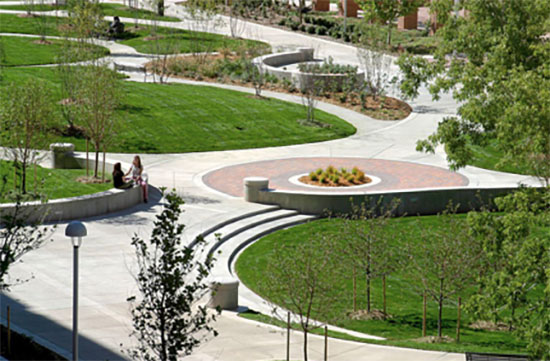
“In all ways, the West End Neighborhood is changing radically—visually, physically and even in terms of the feelings the area evokes,” Wente said. “Students can now walk, gather, sit, talk and engage. We were driven by our desire not only to continue to build a residential college system for our students, but also to activate this part of campus as a place of inclusivity, welcoming and belonging.
“The West End Neighborhood impacts all of the academic areas that surround it, as well as how our campus community is viewed and how it comes together,” she said. “A lot of the work that’s being done in this neighborhood is designed to define the gateways and greenways to other parts of campus, and to explore how we can embrace the West End Neighborhood as part of that greater connectivity,” she said.
Central Neighborhood
Located at the geographic center of campus, the Central Neighborhood encompasses the area that includes Branscomb Quadrangle, the Student Life Center, the E. Bronson Ingram Studio Arts Center, the Engineering and Science Building and the Central Power Plant. It serves as a crossroads between the north-south and east-west legs of a proposed campus greenway network, which will play a large role in linking together the various neighborhoods. The Historic Core, West End, Athletics and Highland neighborhoods all are within a 10-minute walk of the Central Neighborhood.
In addition, spaces within the Central Neighborhood could form a future corridor of science, engineering and technology buildings on campus. A town hall meeting in April discussed the findings of a recent capital improvement study on the current and future facility needs of the School of Engineering and the School of Medicine Basic Sciences.
“The essence of these findings is that we need to think about our long-term strategies for recruitment and retention, and we need to consider state-of-the-art facilities that will embrace and enrich the high caliber of our faculty, staff and students working in them,” Wente said. Initial priorities include building out the three “shell” floors of the current Engineering and Science Building, and updating and renovating the Stevenson Center complex to make it easier to navigate and give it a unified identity as a science and engineering hub on campus.
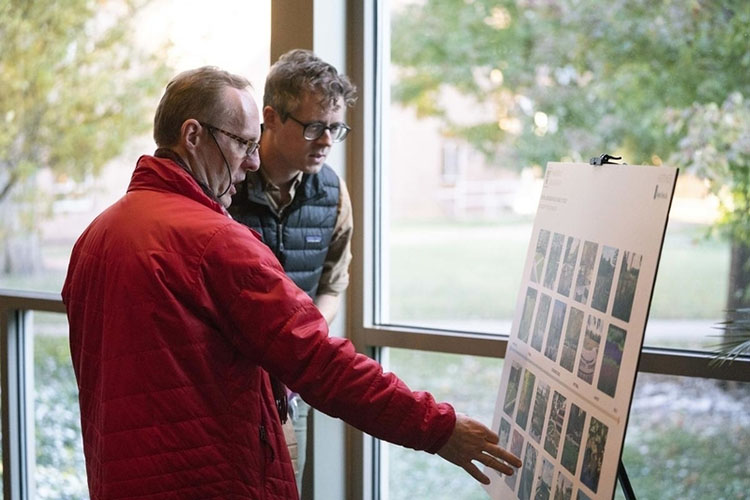
Wente and Kopstain have mobilized staff working groups and appointed an advisory committee comprised of faculty and students from across the university to provide input and feedback on the development of plans, concepts and scenarios for the Central Neighborhood. The study is taking place over the course of the 2019-20 academic year.
“We want to think about the Central Neighborhood as the central part of the canvas of the university, and about the qualities and characteristics of the outdoor spaces that will ultimately manifest the values that we’ve been talking about—the creation of community, fostering meaningful interactions, and more,” Kopstain said.
Following a brief question-and-answer session, the town hall concluded with an interactive exercise inviting those in attendance to envision the design and programming of outdoor spaces in the Central Neighborhood.